The Draco Trio is a close grouping of three galaxies located in the northern constellation of Draco. The galaxies – NGC 5981, NGC 5982 and NGC 5985 – are members of the NGC 5982 Group. They are also known as the Draco Triplet. They lie approximately 100 to 140 million light years away.
The brightest galaxy of the Draco Trio is NGC 5982, an elliptical galaxy with an apparent magnitude of 11.0. The galaxy is flanked by two spiral galaxies. The face-on spiral NGC 5985 appears at a separation of 7.7 arcminutes, and the edge-on galaxy NGC 5981 is separated by 6.3 arcminutes from NGC 5982. The three galaxies are members of the NGC 5982 Group, but it is uncertain whether they form a compact group.
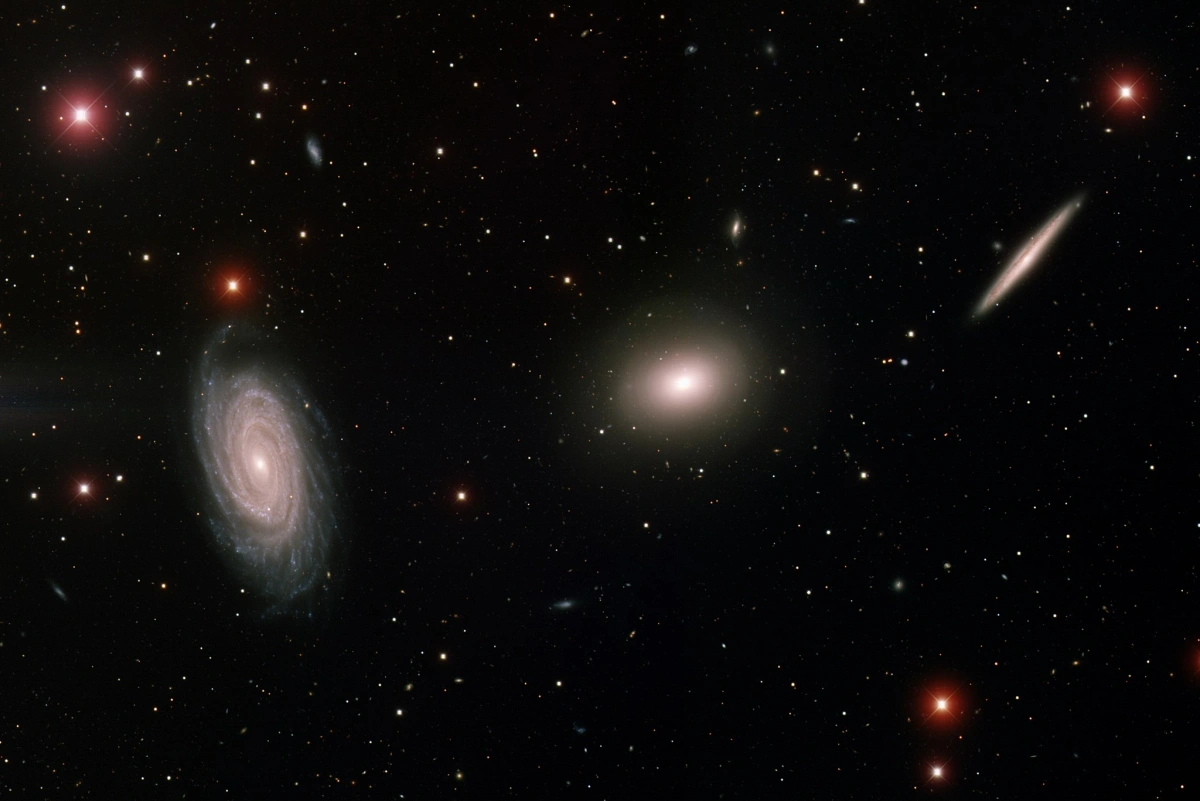
This image was obtained with the wide-field view of the Mosaic camera on the Mayall 4-meter telescope at Kitt Peak National Observatory. The edge-on galaxy NGC 5981 (top), the elliptical galaxy NGC 5982 (middle) and the spiral galaxy NGC 5985 (bottom) form a distinct trio. It is not clear if or when these galaxies might merge with each other. But there is already evidence that NGC 5982 has already merged with one or more smaller galaxies in the recent past. The image was generated with observations in the B (blue), V (green), and I (red) filters. In this image, North is left, East is down. Image credit: T.A. Rector (University of Alaska Anchorage) and H. Schweiker (WIYN and NOIRLab/NSF/AURA) (CC BY 4.0)
NGC 5982
NGC 5982 is an elliptical galaxy with the morphological type E3. It has an apparent magnitude of 11.0 and lies approximately 123 million light-years away. It has an apparent size of 3.0 by 2.1 arcminutes. The galaxy is around 130 million light-years across.
NGC 5982 shows evidence of a merger with a smaller elliptical galaxy. It has a kinematically decoupled nucleus, and its major axis is almost perpendicular to its rotational axis. The galaxy’s envelope contains almost 26 shells arranged in circular arcs along the galaxy’s major axis. The innermost shell appears 8 arcseconds from the nucleus and the outermost is at a separation of 150 arcseconds from the core.
The elliptical galaxy is home to two populations of globular clusters. All of them are over 5 billion years old. The formation of the younger population of stars was probably triggered by the merger with a smaller neighbour.
NGC 5982 is classified as a possible LINER galaxy. It may contain a low-ionization nuclear emission-line region (LINER) in its core. The supermassive black hole at the galaxy’s centre has an estimated mass of 8.3 × 108 solar masses.
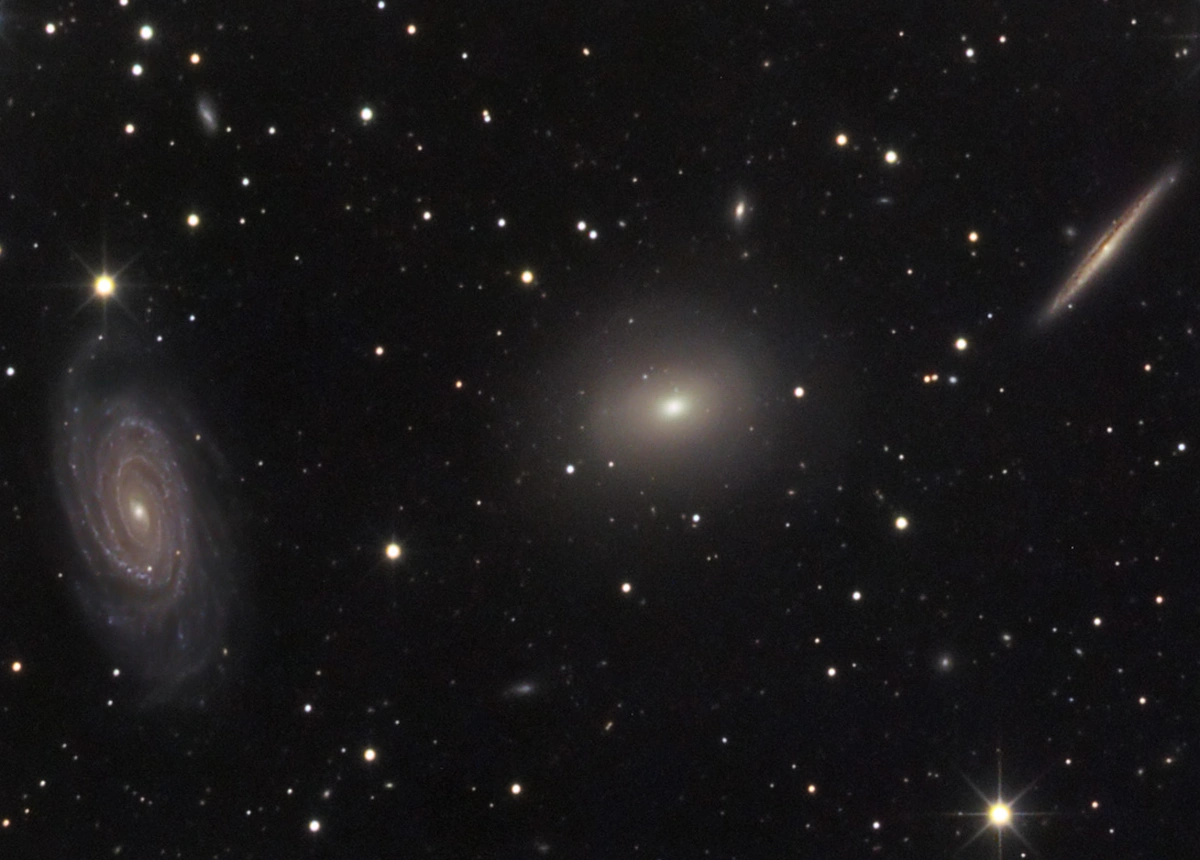
Draco Trio, image credit: Stefan Heutz, Wolfgang Ries and Cord Scholz (Wikisky) (CC BY 4.0)
NGC 5981
NGC 5981 is an edge-on barred spiral galaxy of the morphological type Sab. It has an apparent magnitude of 13.2 and lies 123 million light-years away. It has an angular size of 3.4476 × 0.513692 arcminutes.
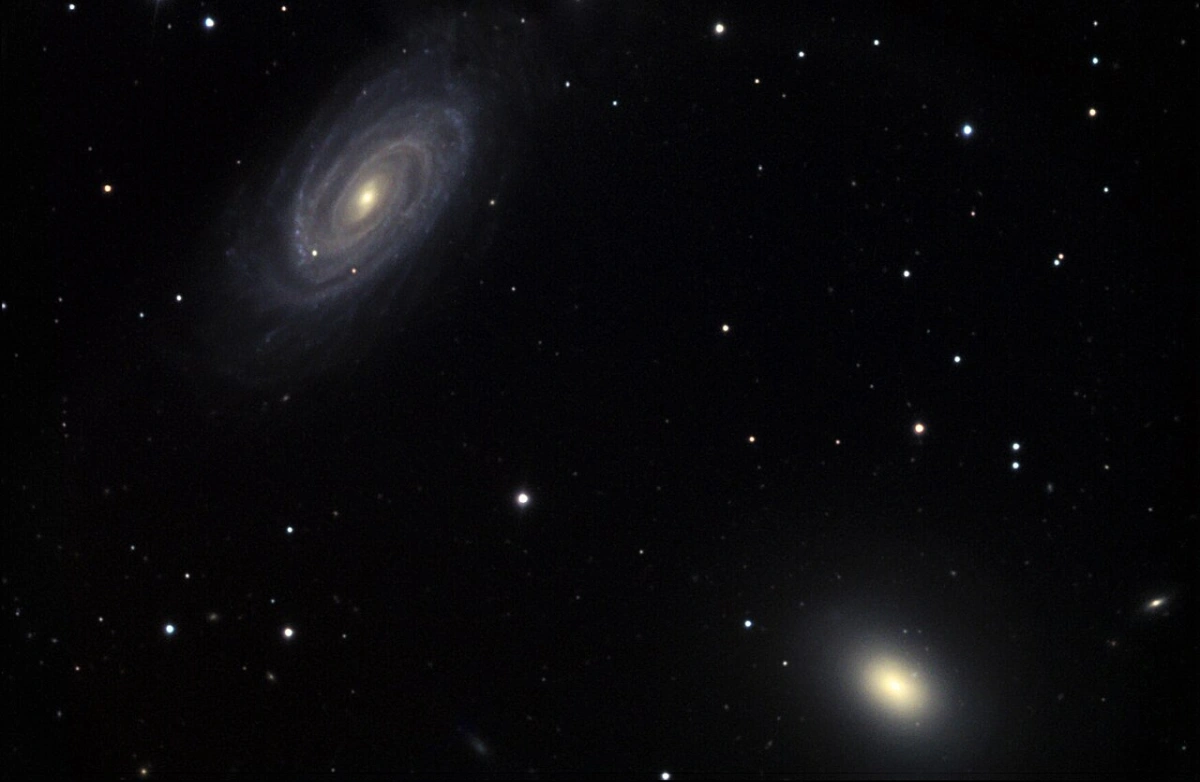
NGC 5985 (face-on spiral, upper-right) and NGC 5982 (elliptical) are two of three galaxies in what is sometimes called the Draco Triplet. The three are about 100 million light years away from Earth.This image was taken as part of Advanced Observing Program (AOP) program at Kitt Peak Visitor Center during 2014. Image credit: KPNO/NOIRLab/NSF/AURA/Richard Robinson and Beverly Erdman/Adam Block (CC BY 4.0)
NGC 5985
NGC 5985 is a spiral galaxy located 140.41 million light-years from the solar system. It appears face-on and has an apparent visual magnitude of 14.22.
With a diameter of 236,900 light years, the galaxy is much larger than NGC 5982. It has an angular size of 4.70578 by 2.36983 arcminutes. It is classified as a barred spiral galaxy of the class SBbc or a weakly barred spiral with the morphological type SAB(r)s.
NGC 5985 is a Seyfert galaxy. It has an active galactic nucleus (AGN) with a supermassive black hole.
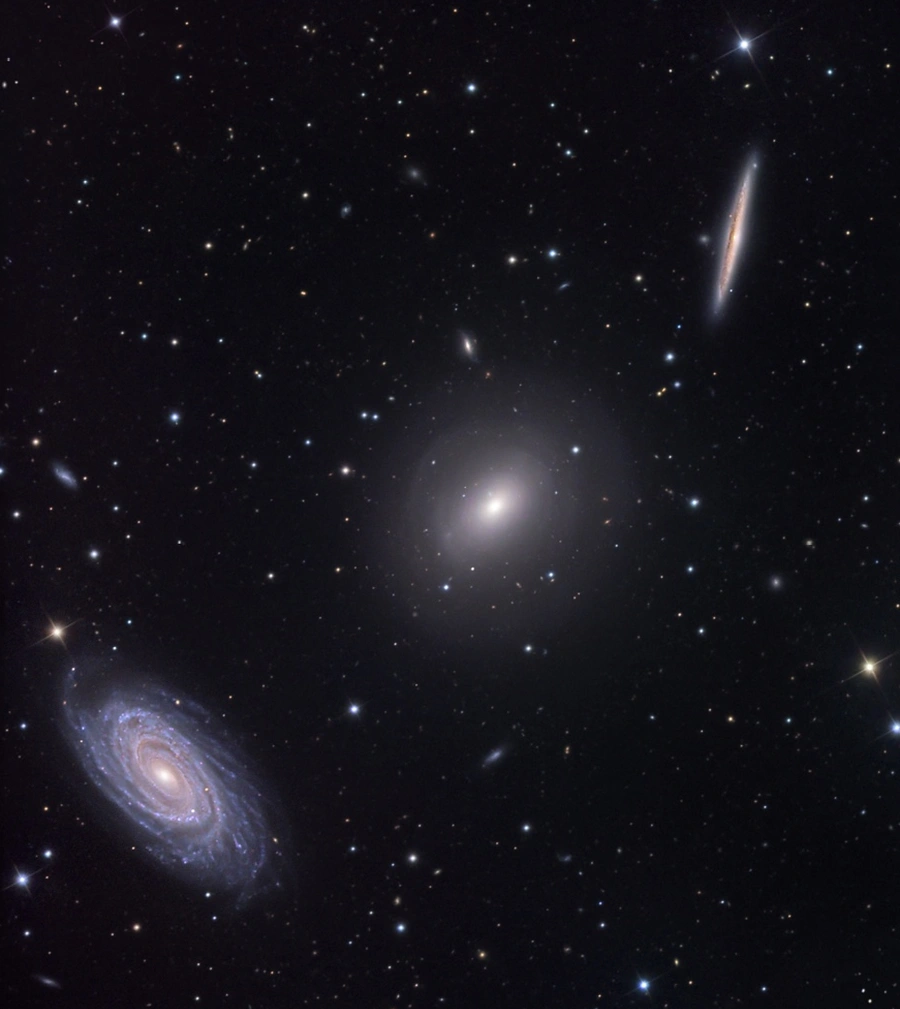
Draco Trio, image credit: Capella Observatory (Wikisky) (CC BY 4.0)
Facts
Even though they appear close to each other in the sky, the three galaxies that form the Draco Triplet were not all discovered at the same time.
The brighter elliptical galaxy NGC 5982 and the edge-on spiral NGC 5985 were discovered by the German-born British astronomer William Herschel on May 25, 1788. Herschel used his 18.7-inch reflector and spotted the galaxies from Slough, England.
NGC 5981 was discovered about 60 years later, on May 6, 1850, by the Irish astronomer George Stoney. Stoney observed the fainter edge-on spiral with the 72-inch reflector known as the Leviathan of Parsonstown from Birr Castle in Count Offaly, Ireland. The Leviathan was built by William Parsons, 3rd Earl of Rosse, in 1845. It was the world’s largest telescope until 1917, when the 100-inch Hooker Telescope was constructed in California.
The elliptical galaxy NGC 5982 is the brightest member of the NGC 5982 Group, sometimes also called the Draco Group. Along with the Draco Triplet galaxies NGC 5985 and NGC 5981, members include NGC 5987 and NGC 5989. The small galaxies NGC 5976 and UGC 9334 (NGC 5976A), which appear in the same field of view, lie at a greater distance.
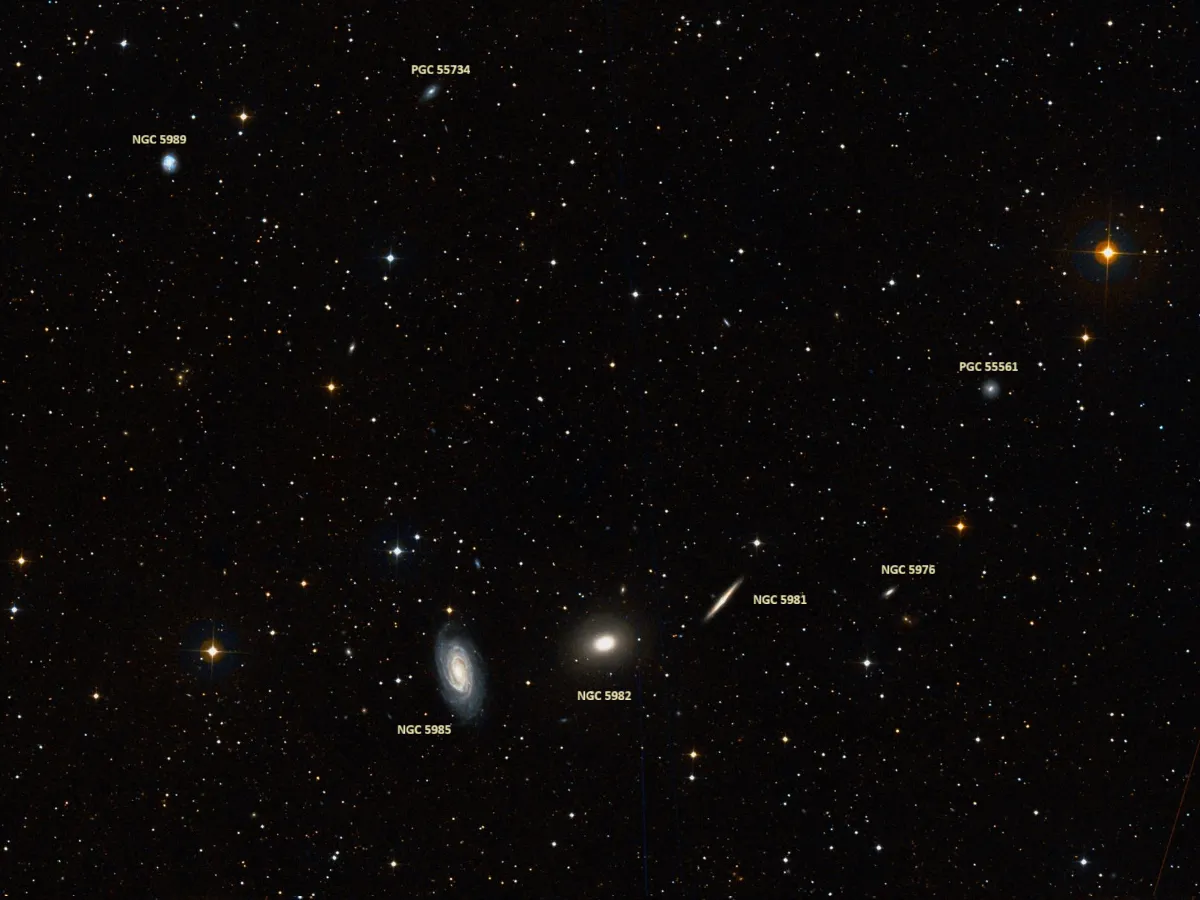
Draco Group, image credit: ESO/Digitized Sky Survey 2 (CC BY 4.0)
Location
The Draco Trio lies in the region between Edasich (Iota Draconis) and Theta Draconis, closer to Edasich. The orange giant star can be found close to the imaginary line extended from Polaris, the North Star, though Pherkad, the fainter of the two Guardians of the Pole. Pherkad and the brighter Kochab, the outer stars of the Little Dipper’s bowl, appear parallel to Mizar and Alioth in the handle of the Big Dipper.
NGC 5982 is listed in the Herschel 400 catalogue of deep sky objects that can be observed in amateur telescopes. Both it and NGC 5985 can be spotted in 6-inch telescopes in good conditions. NGC 5981 is a more challenging target because it is much fainter and appears edge-on. It may be seen in larger telescopes, along with the nearby NGC 5976.
At declination +59°, the Draco Trio is best seen from the northern hemisphere. The galaxies never rise for observers south of the latitude 31° S.
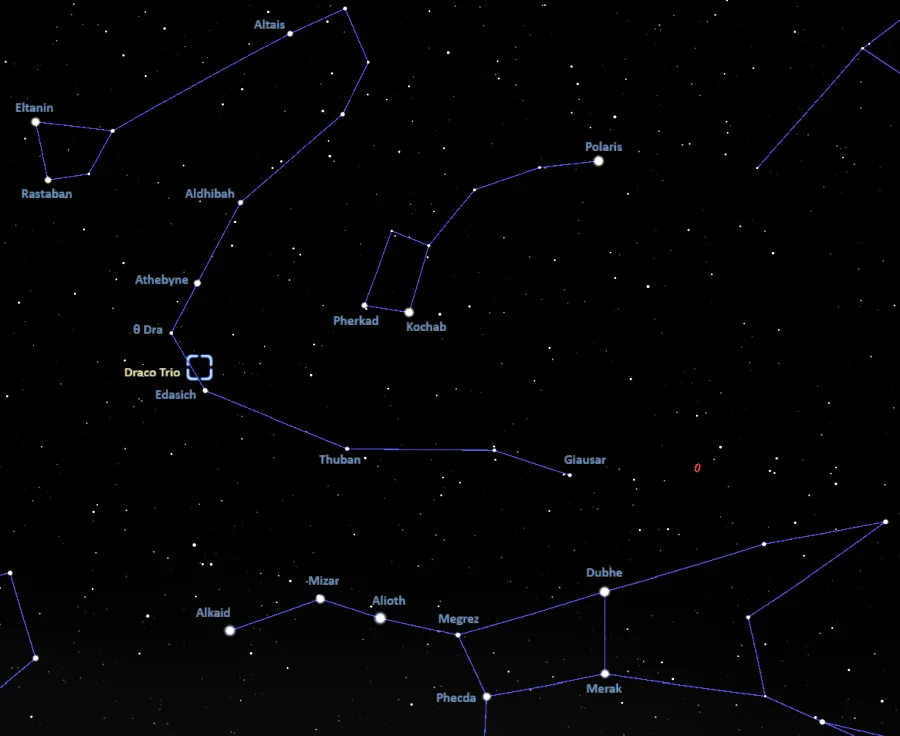
Draco Trio location, image: Stellarium
NGC 5981
| Constellation | Draco |
| Object type | Barred spiral galaxy |
| Morphological type | Sab |
| Right ascension | 15h 37m 53.5014542688s |
| Declination | +59° 23′ 30.529061988″ |
| Apparent magnitude | 13.2 |
| Apparent size | 3.4476′ × 0.513692′ |
| Distance | 123 ± 9 million light-years (37.80 ± 2.65 megaparsecs) |
| Redshift | 0.008690 |
| Heliocentric radial velocity | 2,594 km/s |
| Names and designations | NGC 5981, LEDA 55647, PGC 55647, UGC 9948, MCG+10-22-027, 2MFGC 12588, IRAS 15368+5933, 2MASX J15375345+5923304, ISOSS J15378+5923, K79 64A, Z 297-23, PSCz Q15368+5933, SDSS J153753.45+592330.3, UZC J153753.4+592329, [CHM2007] LDC 1141 J153753.45+5923304, [SLK2004] 1157, Gaia DR3 1602990307215941376, Z 1536.8+5933 |
NGC 5982
| Constellation | Draco |
| Object type | Elliptical galaxy |
| Morphological type | E3 |
| Right ascension | 15h 38m 39.778s |
| Declination | +59° 21′ 21.21″ |
| Apparent magnitude | 11.0 |
| Apparent size | 3.0′ × 2.1′ |
| Distance | 123 ± 34 million light-years (37.6 ± 10.5 megaparsecs) |
| Redshift | 0.010064 ± 0.000031 |
| Heliocentric radial velocity | 3,017 ± 9 km/s |
| Diameter | 130 million light-years |
| Names and designations | NGC 5982, LEDA 55674, PGC 55674, UGC 9961, CGCG 297-024, MCG +10-22-029, 2E 3483, 2E 1537.6+5931, K79 64B, 1RXS J153840.1+592118, RX J1538.6+5921, 2MASX J15383977+5921212, UZC J153839.9+592121, Z 297-24, Z 1537.6+5931, [CHM2007] LDC 1141 J153839.77+5921212, [ZEH2003] RX J1538.6+5921 1 |
NGC 5985
| Constellation | Draco |
| Object type | Barred spiral galaxy |
| Morphological type | SBbc or SAB(r)b |
| Right ascension | 15h 39m 37.0545742176s |
| Declination | +59° 19′ 55.216886664″ |
| Apparent magnitude (V) | 14.22 |
| Apparent magnitude (B) | 15.24 |
| Apparent size | 4.70578′ × 2.36983′ |
| Distance | 140.41 ± 35.18 Mly (43.050 ± 10.785 Mpc) |
| Redshift | 0.008441 |
| Heliocentric radial velocity | 2,520 km/s |
| Size | 236,900 light-years (72,630 parsecs) |
| Names and designations | NGC 5985, LEDA 55725, PGC 55725, UGC 9969, MGC+10-22-030, IRAS F15385+5929, IRAS 15385+5929, [CHM2007] LDC 1141 J153937.08+5919550, Z 297-25, SDSS J153937.07+591955.2, ISOSS J15396+5919, K79 64C, PSCz Q15385+5929, [SLK2000] 74, [SLK2004] 1158, [M98c] 153836.3+592935, SRGE J153937.1+591954, Z 1538.6+5930, UZC J153937.1+591955, TC 851, [VV98c] J153937.5+591958, [VV2000c] J153936.8+591951, [VV2003c] J153936.8+591951, [VV2006c] J153936.8+591951, [VV2010c] J153936.8+591951, Gaia DR2 1602979758777297152, Gaia DR3 1602979758777666432 |